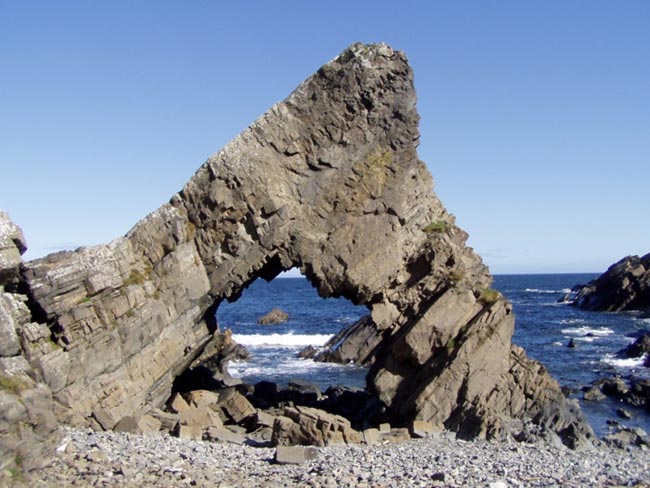Location
To the east of Macduff
Macduff, Aberdeenshire
OS Map Reference
NJ 719 646
Description
Tarlair – Art Deco outdoor swimming pool and boating pond opened in the 1930’s, it was once very popular with tourists, now falling into disrepair, no swimming allowed any more, disused since 1995, currently only used by model boat owners. Classified ‘A’ listed in 2007 by Historic Scotland.
John C Miller (Macduff Burgh Surveyor) 1930-31 with minor later alterations. Art Deco tidal swimming pool, boating pool and paddling pool surrounded by curved walkways, with associated tea pavilion at head of boating pool and changing rooms and kiosks to side. Concrete pools and buildings.
BOATING POOL, SWIMMING POOL AND PADDLING POOL: D-plan boating pool bounded by 3 broad walkways swept round from tea pavilion at head of pool; shallow steps cut into walkways at regular intervals; ramp for boats to E of tea pavilion. Rectangular paddling pool with curved corners enclosing natural rocky outcrop within the boating pool and directly in front of tea pavilion. Rectangular swimming pool to N (sea side) of boating pool with changing rooms at W end; continuation of lower walkway divides boating pool from swimming pool; middle walkway continued round to E end of pool.
TEA PAVILION: single storey, break-fronted rectangular-plan, flat-roofed Art Deco tea pavilion with 3-bay colonnade between taller end pavilions; steps at outer bays leading to roof terrace; simple horizontal railings to roof. Later 2-bay addition to W. Doors and windows boarded up (2006).
CHANGING ROOMS: low, flat-roofed group of 4 linked blocks with slightly advanced outer bays. Strip windows at eaves level (boarded up, 2006).
KIOSKS AND FENCE: probably early 1950s. 2 1-bay, roughly square-plan kiosks at pool entrance. Curved concrete fence with perforated top extends towards tea pavilion.
Tarlair Well – Tarlair Well a chalybeate spring east of Macduff was discovered in 1770 and ten year later in 1780 the Earl of Fife built the ‘Well House’ and the croft. The well was once renowned for its medicinal properties and was very popular for the ‘taking of the waters’ in the 19th century. The well ceased to flow after a German mine exploded when it came ashore in ‘World War Two’. Local drinks manufacturer Sangs traced the source of the well and are said to make all their drink products with this water. The well-house remains although in poor condition, nothing remains of the croft. The well house is category C listed.
Later 18th-early 19th century. Small rectangular rubble wellhouse with later harling. Blocked entrances in E and W gables. Small soak-away vent in base of N elevation. Piended bellcast concrete roof, probably replacing earlier stone slab covering.
INTERIOR: vaulted rubble interior; dished stone gutter runs through centre; rough stone benches against W wall.
A cottage/crofthouse once stood nearbye but during WW2 the same mine which came a shore destroyed it.
The Crazy Frog (Face in the rocks)
A natural face in the rocks which has had its mouth eyes and nostrils added to bring it out.
Painted in 2007.
Cleaved Head, Macduff – Site of a promontory fort, typical in type of the iron age, a scheduled ancient monument, two ditches and traces of a third are evident. The construction of a golf course (Tarlair Royal Golf Club) has altered the landscape around the ditches, but the easternmost ditch is still the best preserved, having a scarp 1.5m high and a counterscarp 0.5m high; no evidence of fortification was seen on the flattish top of the promontory . Grid ref NJ 721 647. Spectacular views of the rugged coastline eastward to Troup Head can be had from here.
Related Information
A remarkably fine, little-altered and early example of an outdoor Art Deco swimming pool. It is one of only 3 known surviving sea-side outdoor swimming pool complexes in Scotland, and certainly the one that best retains its original appearance.
It has a poignant atmosphere of nostalgia for a time when it was thronged with life in an era of lost optimism.
Era
Various
Information Source
RCAHMS, listed building record, SMR and Stanley Bruce
Categories
- Archaeological
- Architectural Decoration
- Outsider Art and Folk Art
- Town Crosses, Fountains, Armorial, etc
Iconography
- frog
Photographer
- Stanley Bruce
Unavailable Data
- Date
- Related Artefacts
- Creator
- External Links
This content was submitted by external contributors and does not necessarily reflect the views of the University of Aberdeen.








